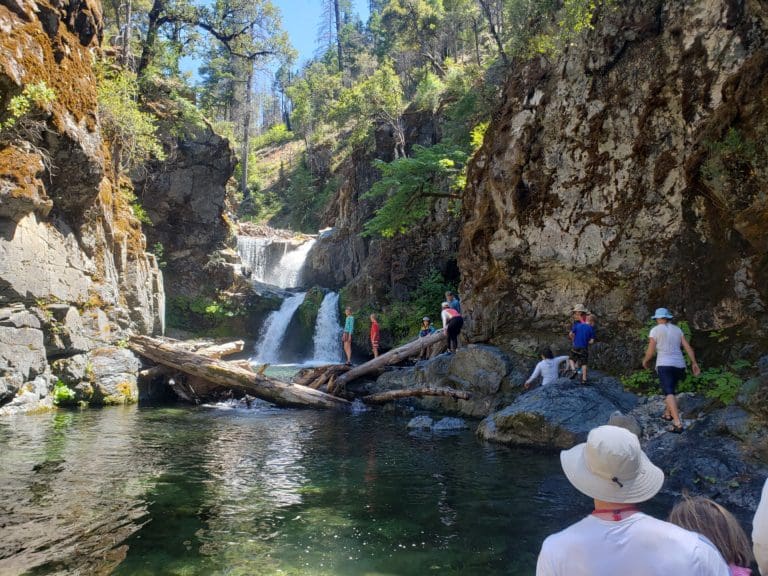
The Klamath River’s headwaters are in Oregon, and it flows from a combination of underground springs, rivers, marshes, and lakes. As a Wild and Scenic River, the Lower Klamath is renowned for its fish and wildlife. Black bears, otters, deer, steelhead, and Chinook and coho salmon can all be seen along the river. There’s even a chance you could see Bigfoot — the Lower Klamath also follows the “Bigfoot Scenic Byway,” which boasts the most sightings of Bigfoot in the country.
The Klamath River Basin is also a crucial stop along the Pacific Flyway, which extends from Patagonia to Alaska and is one of four major migratory bird routes in North America. Over a billion birds use the Pacific Flyway each year, including the largest population of eagles in the Lower 48 states, which winter in the wildlife refuges near the California border. The Lower Klamath River is a birdwatcher’s paradise!
The name “Klamath” itself was derived from the Chinook word “tlamatl”, which means swiftness. The Klamath River was once the third largest salmon-producing river on the West Coast, and Native Americans, including the Klamath, the Modoc, and the Yahooskin-Paiute people, have relied on the river’s fisheries for over 7,000 years. In the 1820s, European fur trappers entered the Klamath River Basin for the first time, followed shortly after by prospectors drawn there by the California Gold Rush. Conflicts and diseases brought by Europeans decimated the Native American population by 90 percent, but some Native American tribes still retain their indigenous homelands along the river.
Conservation efforts are underway to remove four dams constructed in the early and mid-twentieth century along the Upper Klamath River. This is one of the largest dam removal projects in the world, and it will hopefully restore the river’s ecosystem and increase fish habitat throughout the river.
Yes, on our wilderness Klamath rafting trips inflatable kayaks are available for our guests to enjoying. Previous kayaking skills are not required, but folks interested should be adventurous and in good shape.
It depends which section you are rafting. Our Lower Klamath River trips are Class II and III and are perfect for families and for those who haven’t been rafting before.
There are 4 hydroelectric dams scheduled for removal on the Klamath River.
There are camping, cabin and hotel options in and near Happy Camp, CA.
The lower Klamath River is a Beginner to Intermediate course that has Class 2-3.
The Klamath River runs through southern Oregon and northern California.
While on the Lower Klamath River, fishing is a popular activity to do on the course. This is namely due to the large population of salmon that inhabit the river.
The total trip length is 28 miles, therefore it takes 3 days total.
It is a vital watercourse renowned for its scenic beauty, diverse ecosystems, and cultural significance. The Lower Klamath River is also a refuge for birds during migration season.
The best place to fish would be in the lower section of the river.
The river supports diverse fish populations namely for species such as salmon and steelhead fish. These fish play an integral role in the region’s ecological dynamics. Fishing is a great activity for when visitors at overnight camps.
The biggest rapids on the Lower Klamath River are the Kanaka Falls/Rattlesnake and the Class 3+ Dragon’s Tooth
If individuals are not comfortable with swimming, they are still welcome to experience the rafting course.
We hold deep respect for the ancestral Indigenous lands that we operate on.
The Klamath River Basin has been home to Indigenous communities for thousands of years, including the Yurok, Karuk, Hoopa, Shasta, and Klamath tribes, who have cultivated a deep connection with the river and maintain the health of the river today. The name “Klamath” was derived from the Indian word “Tlamatl”, which means “swiftness” in the Chinook language.
Acknowledging the Indigenous communities whose lands we visit is a crucial step in understanding our shared history and the ongoing challenges faced by these populations today. For more insight, visit our Territory Acknowledgement page. We encourage you to learn about the people whose land we’re privileged to explore by following the links above. Our Territory Acknowledgement is an evolving project. If you find missing information or acknowledgments, please share it with us. Together, we can ensure accuracy, inclusivity, and respect. Thank you.